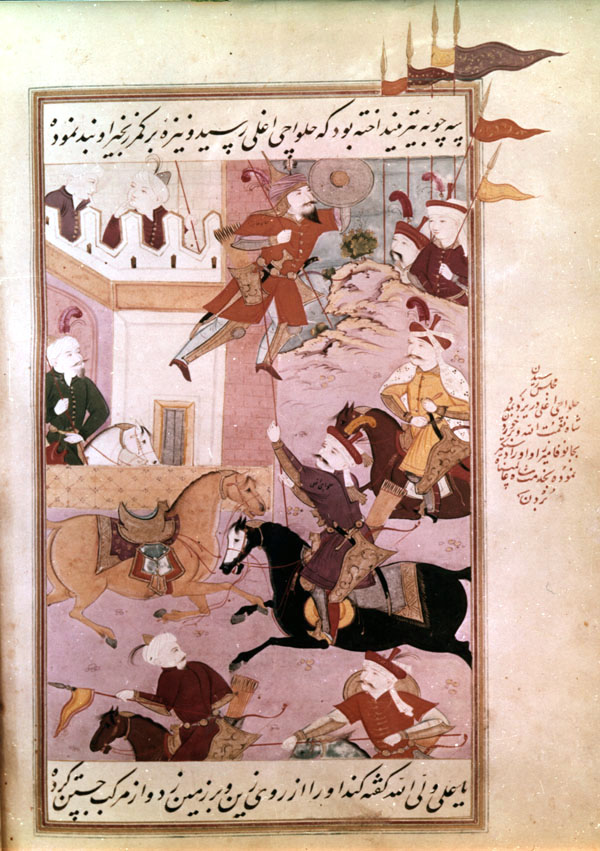Manuscripts
tāriḵ-e ʿālām-ārā-ye šāh esmāʿil
In 915/1509 Šāhibeg Ḵān, more confident with his successes, sent a detachment of troops under the command of his nephew Jān Vafā Mirzā across the desert from Khorasan to plunder Kerman and Yazd. The local ruler of Yazd, Shah Neʿmatollāh, who was a Safavid ally, requested assistance from Shah Esmāʿil. In response to the Uzbeg raid, Esmāʿil dispatched a force under the command of his brother Sultan Ebrāhim Mirzā. Second in command of this detachment was a young qezelbāš of Qajar origins by the name of Ḥalvači Oḡli (also known as Ḥasan Beg), who had distinguished himself at Tabriz in the battle against Alvand Mirzā Torkmān (see folio 51). In the ensuing battle at Yazd between the qezelbāš and Uzbegs, Ḥalvači Oḡli came by chance in direct confrontation with Jān Vafā Mirzā. The two charged each other, and with the point of his lance Ḥalvači Oḡli caught his opponent under the belt and lifted him from the saddle. Quickly the Qajar pounced on his downed opponent and was about to kill him when his prey retorted, “you don’t want to kill me for I am the leader of these troops”. Hearing these words, Ḥalvači Oḡli bound Jān Vafā and took him prisoner to Shah Neʿmatollāh in whose charge he was left while the qezelbāš pursued the remaining Uzbegs. After expelling the Uzbegs from Kerman and chasing them halfway across the desert, Sultan Ebrāhim and Ḥalvači Oḡli returned to Yazd to pick up their prisoner, and with him in tow proceeded to Azerbaijan to report to Shah Esmāʿil. There Jān Vafā Mirzā remained a prisoner for a short time, only to be returned to Khorasan a little later as a peace gesture to Šāhibeg Ḵān, when Esmāʿil sent Šayḵzāda Lahiji as an ambassador to the Uzbegs in a futile attempt to negotiate an end to hostilities.
In the painting, the two have charged, Ḥalvači Oḡli from the right, Jān Vafā Mirzā from the left, and have met near the center of the composition. Ḥalvāči, in purple with a red and white flat top qezelbāš tāj is astride a black horse. Sword, bow, and quiver case hang from his belt. He has thrust a very slender red lance, now held almost vertical on the page, and at the end of it is Jān

Vafā aloft in the air, the lance tip engaged in his belt. He wears a vermillion coat and pointed helmet; sword, dagger, bow, and quivers hang from his belt. In one hand is a round shield, in the other a narrow lance. His light brown horse strides riderless below. Two mounted figures of high rank, observe the combat from behind their respective combatants. On the right, in yellow with a spotted cape, is probably Sultan Ebrāhim Mirzā, commander of the Safavid contingent. On the left, behind a walled enclosure, sits a bearded Uzbeg on a white horse and wearing green garments. He may be identified as Juli Bahādor, an Uzbeg of near equal rank to Jān Vafā, who reported hs demise back to Šāhibeg Ḵān. Six other personage appear in the scene: two Uzbegs gesture astonishment from behind a crenelated parapet in the upper left, who are balanced compositionally by two Safavids behind the ridge in the upper right. And in the foreground, a Safavid ḡāzi with a lance chases an Uzbeg.
The backdrop is a little more complex than most others in the manuscript. A sloping hillside, colored in light mauve, rises to a craggy ridge in the upper right, on which small shrubs grow, and in the distance is a blue sky. The upper left quadrant is occupied by a pavilion of uncertain spatial organization, rendered in white, beige, light salmon, and light purple. Behind a low tiled wall, is what appears to be a square structure with rectangular windows, and a crenelated embattlement and balcony above.
Painting: 23.6 x 16.3 cm.with one line of text above and below. Frame encloses painting and text except for five standards in the upper right that protrude into the margin. No signs of damage or retouching. A marginal inscription in red, presumably of later date, describes the event depicted. Inscriptions in black on two of the figures, identify them as Jān Vafā Mirzā and Ḥalvāči Oḡli.
Painting references:
Mahboubian_1972, #923 folio 186v (not ill.). where Jān Vafā Mirzā is transcribed as Janoufa Mirzā.
Text X-references:
See Muntaẓer-Ṣāḥeb_1970, p.333 for this event in the History of Shah Esmāʿil.
See Savory, SA_1979, pp.59-60 for this event in the History of Shah ʿĀbbās.
Robert Eng
Last Updated: December 13, 2010
Originally published: April 4, 2002